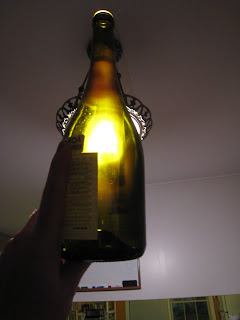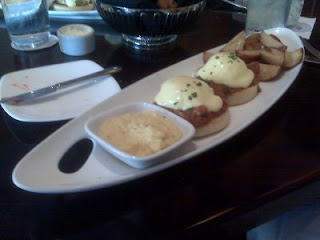At long last, I'm finally getting my post up about my tasting methods and stuff. First, let me start off by saying THANK YOU to all the guest bloggers last week, and thank you, readers, for bearing with me and being so patient awaiting this post! Also, I want to give just a bit of background on how this whole week came about.
About two weeks ago on the
wine.woot! forums, we got into a discussion about the tasting notes that polarbear22 had posted about the then-current offering. In an effort to clarify his scoring, we realized, hey, you know, this scoring thing is so subjective, maybe it'd be good to know how we actually do it.
Corrado posted up his play-by-play notes, and I started going on about how I score the color of a wine. And then it hit me - let's get some of the wine bloggers together and do this!
And so was born the guest week of notes about tasting notes. I'm frankly honored by the response I received to this, and amazed at how quickly we pulled it together and how well it came together. Despite my unfortunate delay!
But enough chatter, onto my notes!
Color: Possible 5 points
My understanding is that color should generally be scored on clarity (shouldn't be a cloudy wine), how appropriate the color itself is to the varietal (a PS should not be pale, a zin should not be black, a white should not be rose), the depth of the color (can you see a light through it), and the top layer (does the color bleed to the edge or is there a clear meniscus on it, and if so, how badly). For example, I would expect a sangiovese/cabernet/merlot blend to be ruby toned, garnet at the deepest. I'd be a little worried if it was darker or lighter than that. I'll start taking points off for color deviations, and for how far from the edge of the glass the color fades out or goes clear. If it's a red and it becomes clear more than 1/8" from the edge of the glass, I take a full point off, for example. Whites are harder since it's typically more difficult to see where it stops being "color" and starts being clear. It's HARD for any wine to score lower than a 4. Very hard.
This is the first thing I look at when sampling a wine. I'll hold the glass up at an angle toward a good bright light, and see if I can see the bulb through it, and asses the color from there. Here ends any sort of scientific rating, and begins everything that's subjective. The glass gets a swirl and my nose dives into it.
Nose: Possible 15 points
It usually takes me three or four good sniffs before I start actually judging what I'm smelling. The first couple of whiffs help clear out any other scents and make sure my sinuses are fully filled with the scent of the wine. The more I can pull out of the scent, the higher I rate it. If it's totally off-putting, it gets a lower score. If it's one of those sit-and-sniff-all-day noses, it gets a higher score. But at this point, I don't put a number on it yet. I'll keep track of all the scents I pull out, and my impression of it (did I like it, was it strong, did it burn my nose from the alcohol).
Next up, the glass is tipped, and a taste is taken.
Flavor: Possible 10 pointsI'll take a sip and give a quick swish and swallow without paying too much attention to it, just to coat the inside of my mouth with the wine and abolish all other flavors. Then I'll take a good little swig and do the lovely aerating thing by sucking in some air. This sometimes results in coughing and spattering as the wine goes down the wrong pipe... but I've gotten pretty good at it. I'll do the same thing here, swirling it around in my mouth, keeping track of all the flavors I pull out of it, along with the impression of it for whether I liked it, and how hot or smooth it tasted. But once again, no point value is given yet.
And then the official swallow.
Finish: Possible 10 pointsHow smoothly the wine goes down plays a big part of the finish to me, as I keep track of it from swallow to the point where I can't taste it anymore. The length of the finish doesn't really play too much into the score I give, unless it is unusually short or nonexistent. Again, I keep note of the flavors that come out post-swallow, how pleasant it is, and how sharp or smooth it feels going down. ClayFu of
ClayFood once commented about how a wine made his throat "uncomfortable", and this saying stuck with me for describing the smoothness of a wine's finish. If it makes my throat uncomfortable, it gets a lower score for being harsh. If it goes down so easily that I almost forget I'm drinking wine (dangerous!), it'll get a higher score. This is also where I make note of the tannins and how strong they are. This will play into the next scoring portion as well. And yet again, I don't actually assign a point value yet.
And here's where the REALLY subjective part comes.
Aging: Possible 5 pointsHow long do I think this will hold up? I'm no expert at this. My understanding is that the stronger the tannins and fruit, the longer it's likely to hold up, and maybe even require more time. I've certainly had a few "too young" wines, and a few "past its prime", so at least I have some basis. Whites generally score lower in this than reds do. The residual sugar may help, but I think the tannins play quite a big role. Sometimes I'll come back and update the aging potential score a few days after the initial tasting because I'll have the wine in the fridge for a few days before trying it again. The longer it holds up in the fridge generally indicates a longer cellarability potential.
Overall: Possible 5 pointsThese are the points that can sway just based purely on how much I enjoy the wine. While there is SOME objectivity to the nose and flavor of the wine, this one is purely me. A wine can be varietally "correct", but I hate it anyway. That's just my own palate preferences.
So at this point, I have actual point values assigned to the color, aging, and overall categories. This is where the research comes in. For the other three that I just kept notes on, I'll go look up what the "typical" characteristics are that you'll see for the varietal of wine, and compare that to what I got. I'll also try to get the winemaker's tasting notes, and see if it holds true. I will never make a change to my notes at this point - what I got was what I got. The more "accurate" the characteristics of this wine are, the higher the score will go. There's still some subjective enjoyability that plays into it, but for the most part I try to score based on what the wine SHOULD be.
Now that I've got all the points, I'll add them up, then add the "base 50" on to it, and voila! Final score.
I think the height of my blogging experience so far has been when I tasted the
2007 Wellington Sauvignon Blanc, and
Peter Wellington let me know that I hit it pretty spot on, and was definitely in sync with what other reviewers were saying. It's always nice getting that reinforcement, especially from the winemaker himself!

























